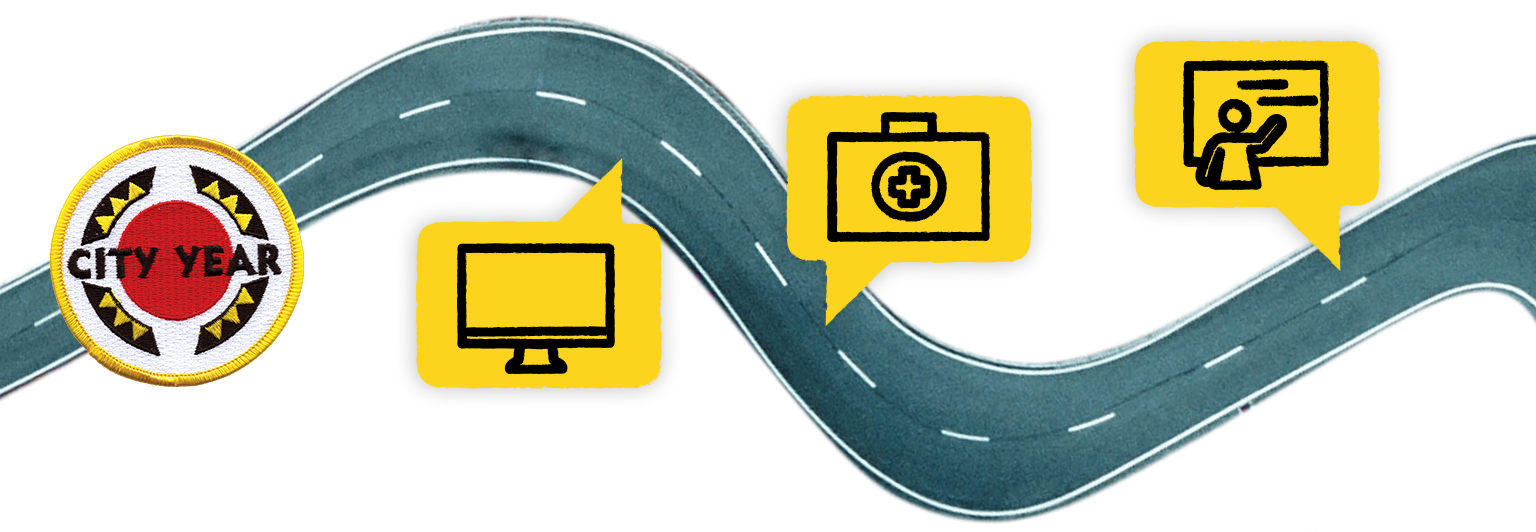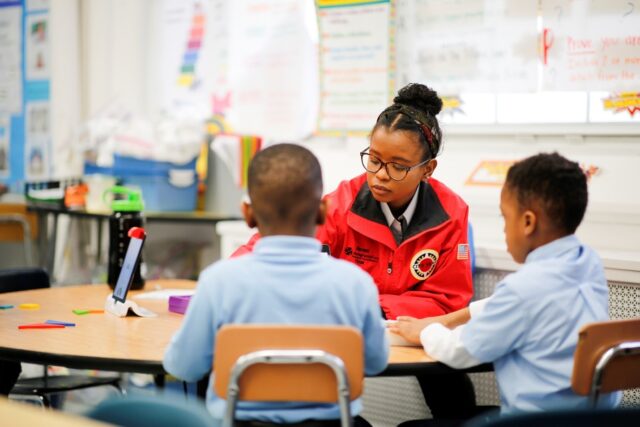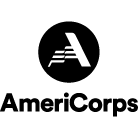City Year teacher pathways foster joy and belonging

Did you know that City Year has designed equity-focused pathways into teaching for AmeriCorps members interested in entering the teaching profession after their year, or two of service in schools is complete?
About half of our alums who responded to a recent survey said they currently worked in the education sector as classroom teachers, administrators, school counselors, or at education-focused nonprofits.
This story explores City Year’s Teaching Fellowship program, a residency model currently operating at City Year Boston and City Year Denver, with plans to expand to City Year Providence in the Fall of 2022, where both undergraduate degree and post-bachelor teacher pathway options will be offered.

Learn more about City Year’s pathways to classroom teaching
Casey Phalen is serving a second year as a City Year Boston AmeriCorps member, partnering with classroom teachers and helping students grow academically, socially and emotionally—but that’s not all she’s doing this year.
Casey is also enrolled in a unique teaching fellowship that enables her to simultaneously earn a master’s in education and a teaching certificate—all for a fraction of the typical cost. The fellowship program is part of City Year’s teacher pathway initiatives that have expanded in recent years, propelled by three factors:
- About half of the young adults who serve with City Year plan to enter the teaching profession or education sector after completing their service. However, many of them experience barriers to entering the field, like affordability. The City Year team began exploring what steps to take to make the profession more affordable and accessible for alumni by creating clearer pathways into teaching.
- City Year AmeriCorps members serve as student success coaches, serving over 1,700 hours in the classroom. This school-based pre-teaching experience, more than triple the national average of 600 hours for a teaching certificate, uniquely prepares City Year alumni to become educators with the powerful skills and mindsets to advance holistic student growth and school success, particularly in under-resourced communities.
- City Year AmeriCorps members and alums are dramatically more diverse than the national teaching force. For example, 10% of our alumni are Black male educators, five times the national average. Our diverse corps provides a direct talent pool of future educators who can diversify the profession and are positioned to advance educational equity.
Casey, a graduate of Williams College, where she was captain of the Ultimate Frisbee team, wasn’t sure what she wanted to do after college. She knew one thing—she loved coaching and mentoring her team.
“I really loved thinking through our team goals,” Casey says. “What should we work on together? How could we use each teammates’ strengths? What was our strategy for each game?”
A friend who knew her well urged Casey to check out City Year. “I still remember her saying, ‘Casey, this is the program for you,” she says. “The rest is obviously history.”
Why City Year is creating pathways for future teachers
City Year’s Teacher Pathways initiative is designed to widen and diversify the pool of young educators available and prepared to support systemically under-resourced schools and help to create welcoming and engaging learning environments, says Jeanette Rojas, City Year School Design Director.
“There are two main objectives of our teacher pathway strategy,” Rojas said. “The first is to identify and support future teachers who can meet students’ growing academic, social and emotional needs, potential and strengths.
“The second is to address two of the biggest challenges facing education: retention and diversity. Our strategy seeks to remove barriers related to recruiting and nurturing a diverse, culturally competent teaching force—educators who are committed long-term to advance educational equity for their students and schools and who are prepared to stay in the profession longer than a few years.”
A year or two of service with City Year offers valuable experience for young adults like Casey who are considering teaching, Rojas said. The holistic approach AmeriCorps members use with students strengthens key skills and mindsets critical for future teachers, such as developing positive relationships with students, setting and implementing long-term goals, and implementing an asset-based approach to pedagogy.
This year, Casey is nurturing her passion as a City Year Teaching Fellow at Mildred Avenue K-8 School in Mattapan. Casey and two other fellows show up for service during the day along with the rest of their City Year team. At night, they attend graduate classes in education both in person or online at UMass Boston or Regis University. By May 2022, they will receive a master’s in education and a teaching license for the state of Massachusetts at a fraction of the typical price.
This means that Casey’s days are long.
She is at her school by 6:30 every morning, an hour before the students arrive. Casey uses that time to organize and prepare for a full day of supporting a sixth-grade classroom until 2:00 PM. Once the students have left, Casey usually lesson plans for an hour before heading off to UMass Boston from 4:00-7:00 PM.
But she says her long days are worth it.
Casey’s first year as an AmeriCorps member helped her realize that she did want to be an educator. Now she’s able to apply what she is learning in the classroom to her graduate studies and vice versa. City Year’s Teaching Fellowship is helping to achieve her goal.
Pivoting from classroom management to joy and belonging
The focus on advancing educational equity and preparing young adults to be culturally competent classroom teachers shows up in unique ways in City Year’s Teaching Fellowship. One example is the pivot away from traditional, often punitive approaches to “classroom management” and dealing with “behavioral issues.”
“Those terms are everywhere,” Casey says. “But they frame the teacher-student relationship as reactionary. So far example, if a student is not following class norms or expectations, the ‘management’ framework focuses on how to react to that moment or behavior.
As City Year Teacher Pathways fellows, Casey says they are reframing that classroom approach.
“As a part of our graduate work, we take L&D session called “Fostering Joy and Belonging in the Classroom,” where we really get at the root of what we want in a classroom or learning environment,” Casey says. “We want to build an inclusive classroom community—a place where students feel like they are cared for and can have joyful interactions with the teacher, students and the learning material. “Students—like all of us—have their good and bad days, Casey says.
“By shifting from the reactionary management of ‘student behaviors’ to creating a joyful and inclusive classroom, we’re putting the work on the instructor,” she says. “As teachers, if we make a welcoming and inclusive classroom environment for our students, they are more likely to show up as their best selves—socially, emotionally, and academically.”
City Year Boston Senior Director Maile Madigan and Brandon Jones, director of academics and development at Compass Academy co-lead the sessions grounded in GLAD strategies. The sessions are held every other week in—person and online. Both UMass and Regis University allow the sessions to count towards credit in professionalism and classroom management courses saving the Teaching Fellows an average of $3,000 in tuition.
Small steps to creating a more inclusive classroom environment
To ‘foster joy and belonging’ in the classroom, you can start small,” Casey says.
In working with her partner teacher, Casey has found the minor changes have been most helpful to her as another adult in the classroom trying to support someone else and listen to the voices and opinions of her students.
“The key is open and honest conversation with your students,” Casey says, “So, in a classroom full of young students going to school in a global pandemic, this means lots of discussions about masks! After a few weeks of frequently asking students to put on or pull their masks up over their noses, I realized that I should explain “the why” behind the school mask rules. So, I decided to have a simple conversation where they shared their feelings.”
Casey’s students said that masks were uncomfortable—they didn’t fit right or were hard to hear when talking to their friends. “I asked them, ‘So, even though masks aren’t always fun, why is it important that we still wear them?’” Casey recalled.
The students all concluded that it’s important to wear masks because they care about each other and caring about each other means caring for their health and safety.
“Since that conversation, I have done a lot less mask monitoring, that’s for sure!” says Casey. “But it just goes to show you that creating a caring environment where students can be heard goes a long way.”
Growing and learning as a future educator
This combination of serving a second year as a City Year AmeriCorps member and concurrent enrollment in a teacher preparation program is helping Casey to think about the kind of educator she wants to be.
“Obviously, I want to be a “good” teacher,” she says. “But our Teaching Fellowship training helps us understand there are many ways to be a “good” teacher. It looks different for everyone.”
So, what does that look like for Casey?
“I know I always want to keep relationships at the center. I am interested in building relationships with individual students,” Casey says. “Still, I want to ensure that my whole classroom feels like a community. That’s one foundational lesson that I’ll carry throughout my career. It’s something that I truly learned during my first corps year, and community building is my biggest focus this year.
Casey also wants to be a fun teacher. Joy can fuel deeper learning.
“I want to have fun finding new ways to reach students and engage them in the material and for my classroom to be exploratory and hands-on. I want my students to understand that learning can be fun. It can be joyful.”
Are you an aspiring educator? Learn more about service with City Year:
City Year’s Teaching Fellowships program in Boston is being supported for a second year by The Vertex Foundation, a City Year National Partner.
Explore other stories about City Year’s teacher pathway work:
Related stories
Every year, thousands of young people decide to join AmeriCorps programs for a year (or more!) of service, helping to...
Read more about Everything you need to know about returning for another year as a City Year AmeriCorps memberCity Year is committed to providing our AmeriCorps members with resources, opportunities and support that help them to achieve their...
Read more about Empowering Futures: City Year Baton Rouge’s Partnership with Bottom LineFatimah Abdulmateen takes service seriously. Fatimah served two years with City Year as an AmeriCorps member, making her an alum...
Read more about A City Year alum with a passion for service—both here and abroadThough this part of the City Year experience may be particularly challenging, it’s also normal! And we want you to...
Read more about The “mid-fall slump” in schools is real--here's what to expect















